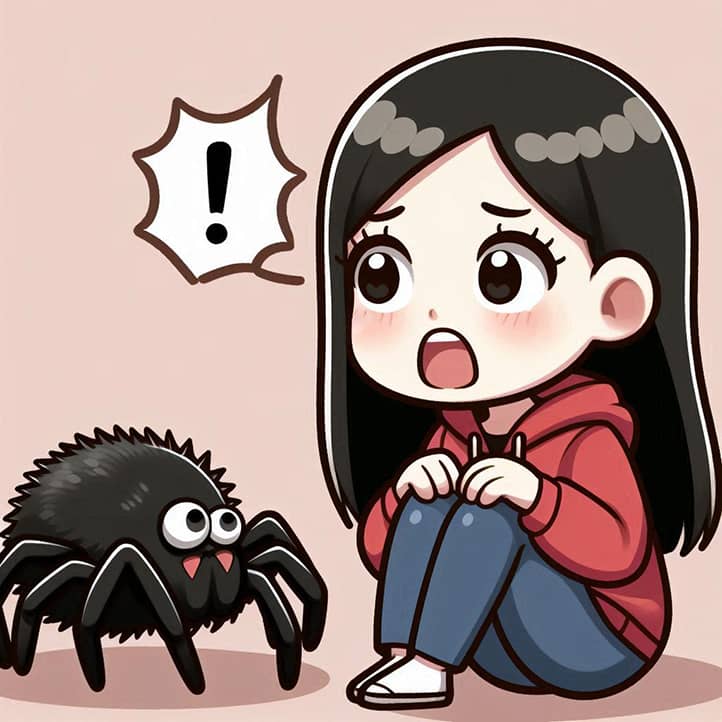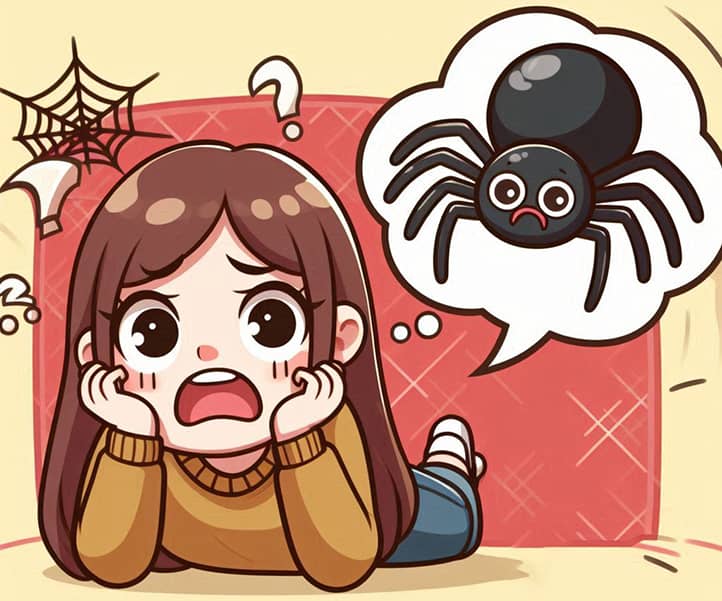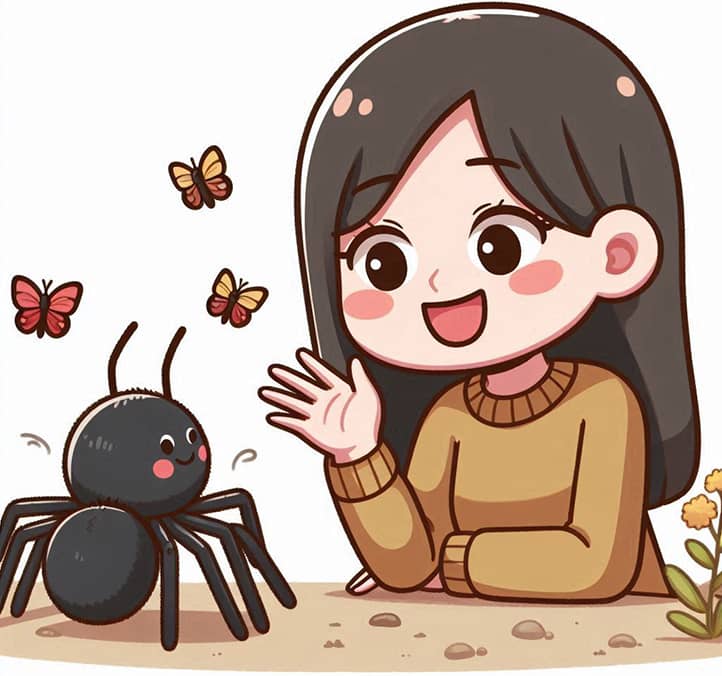Spiders: One of the Most Common Insects on the Planet, but for Many, a Source of Fear and Anxiety. If you experience panic at the sight of even the smallest spider, know you’re not alone. In this article, I’ll discuss what arachnophobia is, why it arises, and how to cope with it.
What is Arachnophobia?
Arachnophobia is an irrational and intense fear of spiders. The word comes from the Greek “arachne” (spider) and “phobos” (fear). It’s important to note that arachnophobia is not just a mild discomfort or dislike of spiders. It’s an intense fear that can seriously impact a person’s daily life.
Studies show that arachnophobia is one of the most common phobias worldwide. Estimates vary, but between 3% and 15% of the global population suffers from this condition. Interestingly, women are more likely to fear spiders than men, though the reasons behind this difference are not fully understood.

Causes of Arachnophobia
The fear of spiders is as ancient as humanity itself. Over thousands of years, people have encountered these eight-legged creatures, and their image is deeply ingrained in our collective subconscious.
Arachnophobia is not always linked to a real negative experience. Often, it is passed down through generations as part of cultural heritage. Parents who fear spiders may unintentionally pass this fear onto their children through their behavior and reactions.
Psychologists note that fear of spiders may symbolically represent deeper anxieties. A spider weaving its web can be perceived as a metaphor for life’s traps or unpredictable dangers lurking in everyday life.
Some researchers suggest a link between arachnophobia and certain personality traits. For example, individuals with high anxiety levels or a tendency toward perfectionism are more prone to developing this phobia.
Understanding the causes of arachnophobia can be the first step toward overcoming it. Let’s look at the main factors that can lead to the development of this fear.
Evolutionary Factors
Many scientists believe that the fear of spiders has evolutionary roots. Our ancestors, who were more cautious around potentially dangerous creatures, including venomous spiders, had a greater chance of survival and passing on their genes to future generations. Thus, a tendency toward caution around spiders may be genetically ingrained.
Cultural Influences
Culture plays a significant role in shaping our fears. In Western culture, spiders are often depicted as sinister creatures in movies, books, and the media. This negative portrayal can intensify fear of spiders, even if a person has never had a negative experience with them in real life.
Personal Experience
Arachnophobia often develops due to a traumatic experience involving spiders. This could be a spider bite, an unexpected encounter with a large spider, or observing someone else’s fearful reaction. Sometimes even indirect experiences, such as watching a horror movie about spiders, can trigger the development of the phobia.

Symptoms of Arachnophobia
Arachnophobia is not just a dislike of spiders; it’s a complex condition that affects all aspects of a person’s life. It can influence choices of residence, career, and even partner.
Interestingly, arachnophobia symptoms can appear even in the absence of an actual spider. Seeing a similar object or merely thinking about a spider can trigger a cascade of physiological reactions.
Some people with arachnophobia report that their fear intensifies during certain life periods, such as during stress or hormonal changes. This indicates a complex link between the phobia and overall bodily condition.
Paradoxically, people with arachnophobia often possess an increased ability to spot spiders. It’s as if their brains are tuned to search for these creatures, which can lead to a constant state of alertness and anxiety.
Arachnophobia may manifest differently for different people, but several common symptoms characterize this condition.
Physical Reactions
When encountering a spider or even thinking about one, a person with arachnophobia may experience the following physical symptoms:
- Rapid heartbeat
- Sweating
- Trembling or shaking
- Difficulty breathing
- Nausea or dizziness
- Tightness in the chest
These reactions are part of the body’s “fight or flight” response and can be very intense, even if the rational part of the brain understands there’s no real danger.
Psychological Manifestations
In addition to physical symptoms, arachnophobia is often accompanied by several psychological manifestations:
- Panic or intense anxiety at the sight of a spider
- Obsessive thoughts about spiders
- Nightmares involving spiders
- Constant worry about the possibility of encountering a spider
- Avoidant behavior (refusing to visit places where spiders may be present)
Impact on Daily Life
In severe cases, arachnophobia can significantly limit a person’s daily life. Here are some examples:
- Avoidance of outdoor activities such as hiking or picnics
- Constant checking of spaces for spiders
- Difficulty focusing at work or school due to fear
- Limiting social interactions due to fear of encountering a spider at someone’s home
- Trouble sleeping due to fear that a spider might crawl into bed

Diagnosis of Arachnophobia
Diagnosing arachnophobia is not just about acknowledging a fear of spiders but is a complex process that requires a deep understanding of the person’s psyche. Specialists consider not only symptoms but also their impact on the patient’s quality of life.
Interestingly, diagnostic criteria for arachnophobia may vary across cultures. What is considered a normal reaction in one society might be regarded as a phobia in another.
Modern diagnostic methods for arachnophobia include not only consultations with a psychologist but also the use of virtual reality technologies. This allows creating a controlled environment to observe the patient’s reactions.
It’s important to note that diagnosing arachnophobia is not just about identifying the problem but also the first step toward resolving it. Understanding the nature and depth of the fear provides the key to choosing the most effective treatment strategy.
Criteria for Diagnosis
According to the Diagnostic and Statistical Manual of Mental Disorders (DSM-5), for a diagnosis of specific phobia, including arachnophobia, the following criteria must be present:
- A marked fear or anxiety related to a specific object or situation (in this case, spiders).
- The phobia object almost always triggers an immediate fear or anxiety response.
- The fear or anxiety is out of proportion to the actual danger posed by the phobia object.
- Active avoidance of the phobia object or enduring it with intense fear or anxiety.
- The fear, anxiety, or avoidance causes clinically significant distress or impairment in social, occupational, or other important areas of functioning.
- The disorder is not better explained by other mental disorders.
Consulting a Specialist
If you suspect you may have arachnophobia, it’s important to consult a qualified specialist—a psychologist or psychiatrist. A professional can not only make an accurate diagnosis but also develop an individualized treatment plan.
During a consultation, a specialist may:
- Conduct a detailed interview about your experience and symptoms.
- Use standardized questionnaires to assess the level of fear.
- Offer tests that involve looking at spider images.
- Rule out other possible disorders.
Remember, seeking help is not a sign of weakness but an important step toward overcoming fear.

Treatment Methods
Treating arachnophobia isn’t just about getting rid of fear. Many patients find that through therapy, they discover new facets of their personality and strengthen their self-confidence.
Interestingly, treatment methods for arachnophobia are constantly evolving. For instance, recent studies show the effectiveness of using EMDR (Eye Movement Desensitization and Reprocessing) in combination with traditional therapy methods.
It’s important to understand that treating arachnophobia is not a linear process. Patients may experience periods of rapid progress followed by temporary setbacks. This is a normal part of the recovery process.
Some psychotherapists offer unusual approaches to treating arachnophobia, such as art therapy or even yoga. These methods help patients develop general stress resilience, indirectly affecting their ability to cope with fear.
The good news is that arachnophobia is treatable. There are several effective approaches that help people overcome their fear of spiders.
Cognitive Behavioral Therapy (CBT)
Cognitive Behavioral Therapy is one of the most effective methods for treating phobias, including arachnophobia. This approach is based on the idea that our thoughts, feelings, and behaviors are interconnected, and changing one aspect can influence the others.
Within CBT, a therapist can help you:
- Identify and challenge irrational thoughts about spiders.
- Learn relaxation techniques to manage anxiety.
- Gradually confront the object of fear in a safe environment.
CBT is usually conducted over several sessions and may include homework to reinforce skills between sessions.
Exposure Therapy
Exposure Therapy is a key component of treating phobias. It is based on the principle that gradual and controlled exposure to the object of fear helps reduce anxiety and fear.
The process of exposure therapy for arachnophobia may include the following stages:
- Viewing images of spiders
- Watching videos with spiders
- Being in the same room as a spider in a closed container
- Observing a spider up close
- Touching a spider (if safe)
It’s important to note that all these steps are carried out under the guidance of an experienced therapist and only with the patient’s consent.
Medication
In some cases, a psychiatrist may recommend medication in addition to psychotherapy. This is especially relevant if arachnophobia is accompanied by other anxiety disorders or depression.
Commonly used medications include:
- Selective serotonin reuptake inhibitors (SSRIs)
- Benzodiazepines (for short-term use in acute situations)
- Beta-blockers (to control physical symptoms of anxiety)
It’s important to remember that medications should be prescribed and monitored by a qualified doctor.

How to Overcome Arachnophobia: Self-Help Techniques
It’s interesting to note that some techniques for overcoming arachnophobia have origins in ancient practices. Meditation and visualization methods used to combat fear have roots in Buddhist and yogic traditions.
It’s important to understand that overcoming a phobia on your own is not a sprint, but a marathon. Progress may be slow and uneven, but every small step is a victory over fear.
Some people find creative ways to work on their phobia. For instance, keeping a “fear journal” where they record their thoughts and feelings, or creating art projects related to spiders. Such creative approaches help them rethink their fear and see it from a new perspective.
Here are several techniques you can use on your own to reduce fear of spiders.
Education and Information about Spiders
Knowledge is power, and this is especially true when it comes to phobias. The more you learn about spiders, the less frightening they will seem. Here are a few facts that might help:
- Most spiders are harmless to humans.
- Spiders play a crucial role in the ecosystem by controlling insect populations.
- Many spider species fear humans much more than humans fear them.
Try reading popular science articles about spiders or watching documentaries about them. Gradually, you may find that your fear lessens as your understanding of these creatures grows.
Relaxation Techniques and Breathing Exercises
Fear is often accompanied by physical tension and rapid breathing. Learning relaxation techniques can help control these symptoms. Here are a few simple exercises:
- Deep breathing: Take a slow breath in through your nose, counting to 4, hold for 2 counts, then exhale slowly through your mouth, counting to 6.
- Progressive muscle relaxation: Tense and then relax each muscle group in your body, starting from your toes and moving up to your face.
- Visualization: Imagine a calm, safe place and mentally transport yourself there.
Practice these techniques regularly so they become automatic in stressful situations.
Gradual Exposure to Spider Images
Self-directed exposure therapy can be effective, but it’s important to approach it carefully and gradually. Here’s a possible plan:
- Start by viewing cartoon images of spiders.
- Move on to realistic drawings of spiders.
- Look at photographs of spiders.
- Try watching short videos featuring spiders.
It’s important not to rush and to move to the next step only when you feel comfortable with the current level.

Tips for Loved Ones
Supporting someone with arachnophobia is not only a show of care but also an opportunity to strengthen relationships. Many couples and families find that working through a phobia together brings them closer and deepens mutual understanding.
Interestingly, the role of a supporter can be just as challenging as that of the person facing the phobia. It requires patience, empathy, and the ability to balance support with providing space for independent growth.
It’s essential to remember that support doesn’t mean completely removing spiders from your loved one’s life. Sometimes, the most effective help is creating a safe environment for gradual exposure to fear.
Some families find creative ways to support a family member with arachnophobia. For example, organizing “spider days,” where everyone learns something new about spiders, or creating a family ritual for safely removing spiders from the house.
If someone close to you suffers from arachnophobia, your support can play a key role in overcoming this fear.
How to Support Someone with Arachnophobia
- Show empathy. Don’t mock or downplay the person’s fear. A phobia is a real and often distressing condition.
- Be patient. Overcoming a phobia is a process that takes time. Don’t rush the person or expect instant results.
- Offer help. Ask how you can assist. They may need company for therapy sessions or support during self-help exercises to overcome fear.
- Learn together. Study information about arachnophobia and treatment methods with your loved one. This will help you better understand their condition and offer more effective support.
- Encourage progress. Acknowledge even small successes in fighting fear. Positive reinforcement can be very motivating.
What to Avoid
- Forcing exposure. Never attempt to “cure” the phobia by suddenly exposing the person to spiders. This can increase fear and traumatize them.
- Invalidating feelings. Phrases like “It’s just a spider!” or “Don’t be a child!” won’t help and will only make the person feel misunderstood and alone in their struggle.
- Overprotectiveness. While support is important, avoid overprotection. Allow the person to handle situations independently when they’re ready.
- Pressure. Don’t push the person to do things they aren’t ready for. The process of overcoming fear should proceed at a pace comfortable for them.
- Comparisons. Avoid comparing with others or with different situations. Every person is unique, and their journey to overcoming fear is individual.

Success Stories
Stories of people who have overcome arachnophobia are not just tales of victory over fear. They are inspiring examples of human resilience and the ability to change. Each of these stories is unique and reflects a person’s personal journey to freedom from phobia.
Interestingly, many people who successfully overcome arachnophobia note unexpected positive changes in other areas of life. Overcoming the fear of spiders often becomes a catalyst for personal growth and confidence.
It’s important to understand that “success” in the context of overcoming a phobia can look different for everyone. For some, it’s the ability to calmly remove a spider from their home, while for others, it’s the ability to observe spiders in a zoo terrarium. Every step forward deserves recognition and respect.
Some people who have overcome arachnophobia find a new calling in helping others with similar fears. They become volunteers in support groups or even professional coaches specializing in phobia management.
Maria’s Story
Maria, 32, had suffered from severe arachnophobia since childhood. She couldn’t stay in the same room with a spider and often asked her husband to check all corners of the house before bed.
After having a child, Maria decided she didn’t want to pass her fear on to her daughter. She consulted a psychotherapist and went through a course of cognitive behavioral therapy. Six months later, Maria was able to calmly remove spiders from the house using a glass and a piece of paper.
“I never thought I could look at a spider calmly, let alone touch one,” says Maria. “But gradual work on myself really works wonders.”
Alex’s Story
Alex, 45, was an avid hiker until one day, while camping, he found a large spider in his tent. This incident triggered severe arachnophobia, preventing him from enjoying his favorite hobby.
Alex decided to fight his fear through self-education. He started reading books about spiders, watching documentaries, and even attended a lecture by a local entomologist.
“The more I learned about spiders, the less frightening they seemed,” Alex says. “Now I’m back to hiking and can even appreciate the beauty of a spider’s web at dawn.”
Sofia’s Story
Sofia, 28, worked as a designer and frequently encountered spiders in her old office building. Her fear was so strong that she considered quitting.
Instead, Sofia decided to try a virtual reality course for phobia treatment. Over several weeks, she immersed herself in virtual scenarios where she encountered spiders in a safe setting.
“Virtual reality allowed me to face my fear without real risk,” Sofia explains. “Gradually, I learned to control my reaction, which helped me cope with spiders in real life.”
These stories show that overcoming arachnophobia is possible, even if fear seems insurmountable now. Each person finds their own path to freedom from phobia, whether through professional therapy, self-education, or innovative technology.

Conclusion
Arachnophobia, despite its prevalence, remains one of the least understood phobias. The fear of spiders, deeply rooted in humanity’s ancient past, continues to affect the lives of millions worldwide. However, modern science and psychology offer many effective ways to overcome this fear.
It’s essential to understand that the fight against arachnophobia is not just about getting rid of unpleasant symptoms. It’s a journey toward a better understanding of oneself, one’s emotions, and reactions. Many people who have gone through the process of overcoming arachnophobia note that this experience changed their lives for the better, taught them to manage stress, and boosted their overall confidence.
Methods for treating arachnophobia continue to evolve and improve. From traditional cognitive behavioral therapy to innovative approaches using virtual reality, everyone can find a method that suits them best. It’s also essential to remember that professional help is often key to successfully overcoming a phobia.
The support of loved ones plays an invaluable role in fighting arachnophobia. Creating a safe and understanding environment where a person can gradually confront and overcome their fear can be the deciding factor in their success. In the end, overcoming arachnophobia is not only a personal victory but also a step toward a fuller, freer life, where fear is no longer a barrier to happiness and self-realization.




